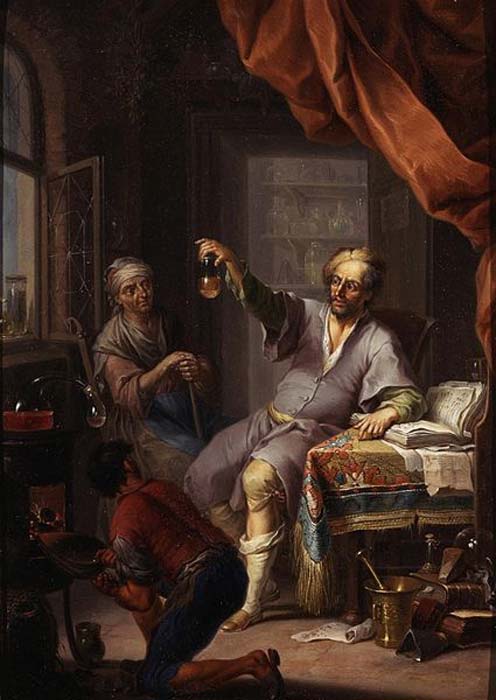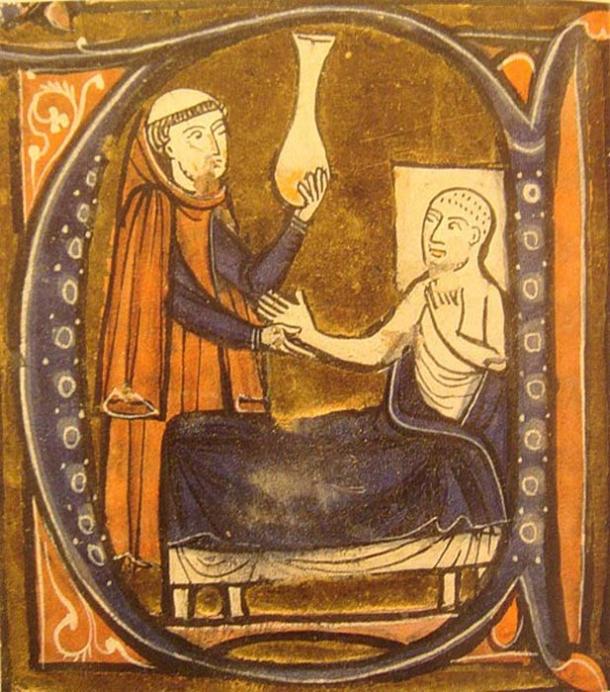
The Urine Wheel and Uroscopy: What Your Wee Could Tell a Medieval Doctor
In modern medicine, urine samples are routinely examined in laboratories to obtain clinical information about a patient. This procedure, known as urinalysis, developed from an older medical process called uroscopy. Although mostly discredited today, doctors used to use a urine wheel to diagnose illnesses up until the middle of the 19th century.
Uroscopy History
The history of uroscopy may be traced back all the way to the ancient Greek and Roman periods. One of the most renowned physicians of the Classical period was Hippocrates, and instructions for the examination of urine can be found in the Corpus Hippocraticum. This is a compilation of medical texts made by various authors belonging to the so-called School of Hippocrates.

‘The Medical Alchemist’ by Franz Cristoph Janneck. (Public Domain)
In the text entitled Prognostics, the different colors and consistencies of urine are mentioned. These two features of a person’s urine may then be used to make prognoses on the course of the disease. However, the physicians of the Classical world did not place too much importance on uroscopy.
- Physician unravels cause of deformities of famous Punch character
- Medieval Medical Books Could Hold the Recipe for New Antibiotics
- Mysteries of the Native American Medicine Wheel – Healing, Rituals, and Astronomical Aid
It was only during the Middle Ages that uroscopy became a significant method of medical examination. One possible reason for this is the fact that during that time, it was considered socially unacceptable to directly examine a patient, or even to disrobe him or her. Therefore, through the observation of a person’s urine, a physician would hope to be able to diagnose his or her illness.

Constantine the African examines patients' urine. (Public Domain)
During the Middle Ages, uroscopy was employed not only by Western European physicians, but also by their Byzantine and Arab counterparts. As a matter of fact, the legacy of the Classical physicians was preserved by the Byzantines, who were succeeded by the Arabs. Moreover, it was through the latter that uroscopy returned to Western Europe.
The Medieval Urine Wheel
Urology was greatly aided during the Middle Ages by the development of the urine wheel. In essence, this was a chart (in the form of a wheel) which helped the medieval physician in his diagnosis of a patient’s illness.
The urine wheel is divided into 20 different parts, each of which shows a different color of urine. In addition to observing the urine, it may be assumed that the physicians of the Middle Ages also relied on their sense of taste and smell, as the taste and smell of a patient’s urine were affected by the illness they were suffering from, and generally corresponded with specific colors.

A Medieval urine wheel. (OnlineRover)
The variations of urine smells and tastes were also described in the urine wheel. As an example, the 17th century English physician Thomas Willis noted that the urine of a diabetic patient tasted “wonderfully sweet as if it were imbued with honey or sugar.” It was Willis who coined the term ‘mellitus’ (meaning ‘sweetened with honey’) in diabetes mellitus, and this disorder was once known as ‘Willis’s disease’.
As uroscopy became such an important tool for physicians of the Middle Ages to diagnose illnesses, many treatises on this subject were written and published all over Europe. Of course, these works would have included the urine wheel, and many examples of this tool for the diagnosis of illnesses have survived till today.

Another version of a urine wheel. (OnlineRover)
It is from these works and urine wheels that we have some understanding of the way in which uroscopy was employed by the medieval physician. One of these, for instance, is Gilles de Corbeil’s De Urinis, a 13th century medical poem on uroscopy. The colors of urine found in this work include green, white, livid, and wine-colored. Needless to say, de Corbeil also instructed his readers on what these different colors say about a patient’s health.
- Shennong: The God-King of Chinese Medicine and Agriculture
- Ayurvedic Medicine: A Traditional Knowledge of Life from India that Has Endured the Passage of Time
- Five things the ancient Greeks can teach us about medicine today

European depiction of the Persian (Iranian) doctor Al-Razi, in Gerardus Cremonensis "Recueil des traités de médecine" 1250-1260. A surgeon (left) holds the matula, a vessel for collecting the urine. (Public Domain)
Chemical Analysis Takes Over
Uroscopy and the urine wheel continued to be used up by European physicians to diagnose their patients, regardless of social status, up until the middle of the 19th century. The urine of George III of the United Kingdom, for instance, is reported to have been purple in color, and it may have been a sign that he was suffering from porphyria, which is a group of diseases that negatively affected the nervous system. It has been speculated that this could have caused the madness that the king was infamous for.

George III of the United Kingdom (1771) By Johann Zoffany. (Public Domain) This king allegedly had blue-tinged or purple pee.
Towards the end of the 19th century, chemical analysis began to be used for the examination of urine. In consequence, uroscopy and the urine wheel fell out of favor, and doctors no longer needed to taste their patients’ urine.
Top Image: Village Doctor Looking at a Urine Sample (1640s) by David Teniers the Younger. Source: Public Domain
By Wu Mingren
References
Agapakis, C., 2012. The Urine Wheel. [Online]
Available at: https://blogs.scientificamerican.com/oscillator/the-urine-wheel/
Cahill, M., 2015. What Medieval Doctors Used To Do With Urine Was Once Disgusting, Cutting Edge Medicine. [Online]
Available at: http://www.viralnova.com/urine-doctors/
European Association of Urology, 2018. Uroscopy. [Online]
Available at: http://history.uroweb.org/history-of-urology/diagnosis/looking-at-the-urine/uroscopy/
Fitzharris, L., 2013. Piss Prophets & The Wheel of Urine. [Online]
Available at: http://www.drlindseyfitzharris.com/2013/12/06/piss-prophets-the-wheel-of-urine/
Medievalists.net, 2014. What does your urine say about your health? (Medieval Version). [Online]
Available at: http://www.medievalists.net/2014/10/urine-say-health-medieval-version/
Nicola, 2012. Urine Flavour Wheels. [Online]
Available at: http://www.ediblegeography.com/urine-flavour-wheels/
The Editors of Encyclopaedia Britannica, 2015. Uroscopy. [Online]
Available at: https://www.britannica.com/science/uroscopy
Black, W. Forget Folk Remedies, Medieval Europe Spawned a Golden Age of Medical Theory. [Online] Available at: http://www.ancient-origins.net/history/forget-folk-remedies-medieval-europe-spawned-golden-age-medical-theory-007507
Leafloor, L. 2015. Medieval Medicine: 1,000-year-old Onion and Garlic Salve Kills Modern Bacterial SuperBugs. [Online] Available at: http://www.ancient-origins.net/news-general/medieval-medicine-1000-year-old-onion-garlic-kills-modern-bacterial-superbugs-020281
Karasavvas, T. 2017. Medieval Men With ‘Unsuitable Seed’ Prescribed Ground Up Pig Testicles. [Online] Available at: http://www.ancient-origins.net/history/medieval-men-unsuitable-seed-prescribed-ground-pig-testicals-008508














